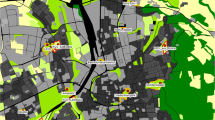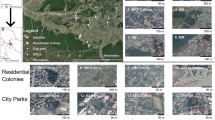Abstract
Increased urbanization typically leads to an increase in abundance of a few species and a reduction in bird species richness. Understanding the structure of biotic communities in urban areas will allow us to propose management techniques and to decrease conflicts between wild species and human beings. The objective of this study was to describe the structure of the bird community in an urban ecosystem. The study was carried out in the city of Taubaté in southeastern Brazil. Point-counts were established in areas with different levels of tree density ranging from urban green spaces to predominantly built-up areas. We looked for a correlation between the richness/abundance of birds and the size of the area surveyed, the number of houses, the number of tree species and the number of individual trees. The results of multiple regression showed that bird richness had a direct relationship with vegetation complexity. The abundance and diversity of tree species were better predictors of bird species than the number of houses and size of the area surveyed. We discuss implications of this study for conservation and management of bird diversity in urban areas, such as the need to increase green areas containing a large diversity of native plant species.





Similar content being viewed by others
References
Álvarez RO, MacGregor-Fors I (2009) Living in the big city: effects of urban land-use on bird community structure, diversity, and composition. Landsc Urban Plann 90(3–4):189–195. doi:10.1016/j.landurbplan.2008.11.003
Bencke GA, Maurício GN, Develey PF, Goerck JM (Org.) (2006) Áreas importantes para a conservação das aves no Brasil. Parte I – Estados do domínio da Mata Atlântica. SAVE Brasil, São Paulo
Bibby CJ, Burgess ND, Hill DA, Mustoe SH (2000) Bird census techniques, 2nd edn. Academic, New York
Blair RB (1996) Land use and avian species diversity along an urban gradient. Ecol Appl 6(2):506–519
Câmara G, Souza RCM, Freitas UM, Garrido JCP (1996) SPRING: integrating remote sensing and GIS with object-oriented data modelling. Comput Graph 15(6):13–22
Catterall CP, Green RJ, Jones DN (1989) Occurrence of birds in relation to plants in a subtropical city. Aust Wildl Res 16:289–305
Chace JF, Walsh JJ (2006) Urban effects on native avifauna: a review. Landsc Urban Plann 74:46–69
Clergeau P, Jokimaki J, Savard J-PL (2001) Are urban bird communities influenced by the bird diversity of adjacent landscapes? J Appl Ecol 38(5):1122–1134
Clergeau P, Croci S, Jokimaki J, Kaisanlahti-Jokimaki M-L, Dinetti M (2006) Avifauna homogenisation by urbanisation: analysis at different European latitudes. Biol Conservat 127:336–344
Colwell RK (2005) EstimateS: Statistical estimation of species richness and shared species from samples. Version 7.5. http://viceroy.ebb.uconn.edu/estimates (accessed in 06/2010)
Daniels GD, Kirkpatrick JB (2006) Does variation in garden characteristics influence the conservation of birds in suburbia? Biol Conservat 133:326–335
Day TD (1995) Bird species composition and abundance in relation to native plants in urban gardens, Hamilton, New Zealand. Notornis 42:172–186
Emlen JT (1974) An urban bird community in Tucson, AZ: derivation, structure, and regulation. Condor 76:184–197
Faeth SH, Shochat E, Warren PS, Marussich WA (2005) Trophic dynamics in urban communities. Bioscience 55(5):399–407
Fernández-Juricic E (2000) Bird community composition patterns in urban parks of Madrid: the role of age, size, and isolation. Ecol Res 15:373–383
Fernández-Juricic E (2004) Spatial and temporal analysis of the distribution of forest specialists in an urban-fragmented landscape (Madrid, Spain). Implications for local and regional bird conservation. Landsc Urban Plann 69:17–32
Fernández-Juricic E, Jokimäki J (2001) A habitat island approach to conserving birds in urban landscapes: case studies from southern and northern Europe. Biodiv Conserv 10:2023–2043
Ferreira FC (ed.) (2007) Biologia e geografia do Vale do Paraíba: trecho paulista. IPEA Editora. São José dos Campos, SP. 192p
Fontana CS, Burger MI, Magnusson WE (2011) Bird diversity in a subtropical South-American city: effect of noise levels, arborisation and human population density. Urban Ecosyst. doi:10.1007/s11252-011-0156-9
Friesen LE, Eagles PFJ, Mackay RJ (1995) Effects of residential development on forest-dwelling neotropical migrants songbirds. Conserv Biol 9(6):1408–1414. doi:10.1046/j.1523-1739.1995.09061408.x
Garaffa PI, Filloy J, Bellocq MI (2009) Bird community responses along urban-rural gradients: does the size of the urbanized area matter? Landsc Urban Plann 90(1–2):33–41. doi:10.1016/j.landurbplan.2008.10.004
Gavareski CA (1976) Relation of park size and vegetation to urban bird populations in Seattle, Washington. The Condor 78:375–382
Gill F, Donsker D (2010) IOC World Bird Names (version 2.4). http://www.worldbirdnames.org. Accessed 10 august 2010
Green RJ, Catterall CP, Jones DN (1989) Foraging and other behaviour of birds in subtropical and temperate suburban habitats. Emu 89:216–222
Hodgson P, French C, Major RE (2007) Avian movement across abrupt ecological edges: differential responses to housing density in an urban matrix. Landsc Urban Plann 62:55–68
Hostetler M (1999) Scale, birds, and human decisions: a potential for integrative research in urban ecosystems. Landsc Urban Plann 45(1):15–19. doi:10.1016/S0169-2046(99)00025-0
IBGE, Instituto Brasileiro de Geografia e Estatística (2001) www.ibge.br/Censo
Jokimäki J (1999) Ocurrence of breeding bird species in urban parks: effects of park structure and broad-scale variables. Urban Ecosyst 3:21–34
Jokimäki J, Kaisanlahti-Jokimäki M-L (2003) Spatial similarity of urban bird communities: a multiscale approach. J Biogeogr 30:1183–1193
Jokimäki J, Suhonen J (1993) Effects of urbanisation on the breeding bird species richness in Finland: a biogeographical comparison. Ornis Fenn 70(2):71–77
Jokimäki J, Suhonen J (1998) Distribution and habitat selection of wintering birds in urban environments. Landsc Urban Plann 39(4):253–263. doi:10.1016/S0169-2046(97)00089-3
Khera N, Mehta V, Sabata BC (2009) Interrelations of birds and habitat features in urban green spaces in Delhi, Índia. Urban Forestry & Urban Greening. Green spaces and urban birds, Brazil 8:187–196
Kirchner FF, Detzel VA, Mitishita EA (1990) Mapeamento da vegetação urbana. In: Anais do Encontro Nacional Sobre Arborização Urbana 3. Curitiba–FUPEF do Paraná, pp 72–86
Lancaster RK, Rees WE (1979) Bird communities and the structure of urban habitats. Can J Zool 57:2358–2368
Leveau LM, Leveau CM (2004) Comunidades de aves en un gradient urbano de la ciudad de Mar del Plata, Argentina. Hornero 19(1):13–21
Lin HC, Sodhi NS (2004) Responses of avian guilds to urbanization in a tropical city. Landsc Urban Plann 66(4):199–215
López-Flores V, MacGregor-Fors I, Schondube JE (2009) Artificial nest predation along a Neotropical urban gradient. Landsc Urban Plann 92(2):90–95
MacGregor-Fors I (2008) Relation between habitat attributes and bird richness in a western Mexico suburb. Landsc Urban Plann 84(1):92–98. doi:10.1016/j.landurbplan.2007.06.010
Magurran AE (1988) Ecological diversity and its measurement. Princeton University Press, Princeton
Manhaes MA, Loures-Ribeiro A (2005) Spatial distribution and diversity of bird community in an urban area of Southeast Brazil. Braz. arch. biol. technol. [online]. 48(2): 285–294. Available from: <http://www.scielo.br/scielo
Marzluff JM (2001) Worldwide urbanization and this effects on birds. In: Marzluff JM et al (eds) Avian ecology and conservation in an urbanising world. Kluwer Academic Publishers, Norwell, pp 19–48
Marzluff JM (2005) Island biogeography for an urbanizing word: how extinction and colonization may determine biological diversity in human-dominated landscapes. Urban Ecosyst 8:157–177
Melles S, Glenn S, Martin K (2003) Urban bird diversity and landscape complexity: Species–environment associations along a multiscale habitat gradient. Conserv Ecol 7(1):5. Available at: http://www.consecol.org/vol7/iss1/art5
Miller SG, Knight RL, Miller CK (1998) Iinfluence of recreational trails on breeding bird communities. Ecol Appl 8:162–169. doi:10.1890/1051-0761(1998)008[0162:IORTOB]2.0.CO;2
Mills GS, Dunning JB Jr, Bates JM (1989) Effects of urbanization on breeding bird community structure in southwestern desert habitats. The Condor 91:416–428
Piper SD, Catterall CP (2006) Impacts of picnic areas on bird assemblages and nest predation activity within Australian eucalypt forest. Landsc Urban Plann 78:251–262
Rodewald AD, Shustack DP (2008) Urban flight: understanding individual and population-level responses of Nearctic–Neotropical migratory birds to urbanization. J Anim Ecol 77:83–91. doi:10.1111/j.1365-2656.2007.01313.x
Sandström UG, Angesltam P, Mikusisnki G (2006) Ecological diversity of birds in relation to the structure of urban green space. Landsc Urban Plann 77:39–53
Shochat E, Stefanov WL, Whitehouse MEA, Faeth SH (2004) Spider diversity in the greater Phoenix area: the influence of human modificationof habitat structure and productivity. Ecol Appl 14:268–280
Sick H (1997) Ornitologia Brasileira. Edição revisada por Pacheco, J.F. Editora Nova Fronteira. p 912
Souza MALB, Conte AM, Bardelli G, Latini M (1990) Análise e caracterização da arborização viária da parte central da cidade de Botucatu, SP. In: Anais do Encontro Nacional Sobre Arborização Urbana. Curitiba–FUPEF do Paraná, pp 236–243
Toledo MCB, Donatelli RJ (2010) Spectral analysis of flowers used by nectar-feeding birds in an Southeastern Brazil. Braz J Biol 70(3):729–735
van Heezik Y, Smyth A, Mathieu R (2008) Diversity of native exotic across an urban gradient in a New Zealand city. Landsc Urban Plann 87:223–232
van Rensburg BJ, Peacock DS, Robertson MP (2009) Biotic homogenization and alien bird species along an urban gradient in South Africa. Landsc Urban Plann 92(3–4):233–241
Winters GHM, Perrenoud LAS, Mohamed MHM (1992) A arborização urbana em 295 municípios de São Paulo. In: Anais do Encontro Nacional Sobre Arborização Urbana 4. Vitória – Prefeitura Municipal 2:175-192
Acknowledgements
The authors are thankful to Maria Célia Villac for her support and advice. We also thank two anonymous reviewers who greatly improved the manuscript. Finally, we thank Martha Villac and Alberto Bezerril for the English proofreading.
Author information
Authors and Affiliations
Corresponding author
Appendices
Appendix 1
Appendix 2
Rights and permissions
About this article
Cite this article
de Toledo, M.C.B., Donatelli, R.J. & Batista, G.T. Relation between green spaces and bird community structure in an urban area in Southeast Brazil. Urban Ecosyst 15, 111–131 (2012). https://doi.org/10.1007/s11252-011-0195-2
Published:
Issue Date:
DOI: https://doi.org/10.1007/s11252-011-0195-2




